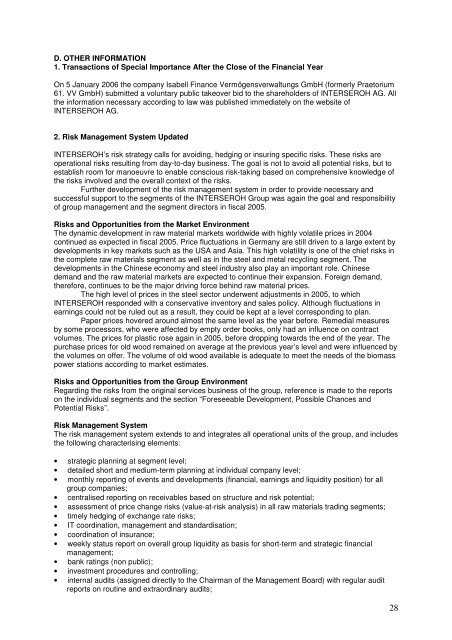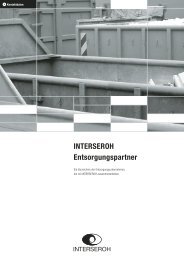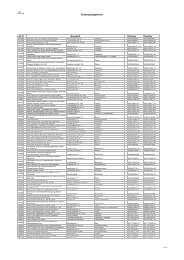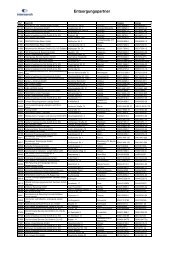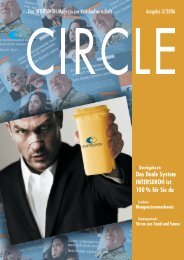Business Report 2005 - Interseroh
Business Report 2005 - Interseroh
Business Report 2005 - Interseroh
Create successful ePaper yourself
Turn your PDF publications into a flip-book with our unique Google optimized e-Paper software.
D. OTHER INFORMATION<br />
1. Transactions of Special Importance After the Close of the Financial Year<br />
On 5 January 2006 the company Isabell Finance Vermögensverwaltungs GmbH (formerly Praetorium<br />
61. VV GmbH) submitted a voluntary public takeover bid to the shareholders of INTERSEROH AG. All<br />
the information necessary according to law was published immediately on the website of<br />
INTERSEROH AG.<br />
2. Risk Management System Updated<br />
INTERSEROH’s risk strategy calls for avoiding, hedging or insuring specific risks. These risks are<br />
operational risks resulting from day-to-day business. The goal is not to avoid all potential risks, but to<br />
establish room for manoeuvre to enable conscious risk-taking based on comprehensive knowledge of<br />
the risks involved and the overall context of the risks.<br />
Further development of the risk management system in order to provide necessary and<br />
successful support to the segments of the INTERSEROH Group was again the goal and responsibility<br />
of group management and the segment directors in fiscal <strong>2005</strong>.<br />
Risks and Opportunities from the Market Environment<br />
The dynamic development in raw material markets worldwide with highly volatile prices in 2004<br />
continued as expected in fiscal <strong>2005</strong>. Price fluctuations in Germany are still driven to a large extent by<br />
developments in key markets such as the USA and Asia. This high volatility is one of the chief risks in<br />
the complete raw materials segment as well as in the steel and metal recycling segment. The<br />
developments in the Chinese economy and steel industry also play an important role. Chinese<br />
demand and the raw material markets are expected to continue their expansion. Foreign demand,<br />
therefore, continues to be the major driving force behind raw material prices.<br />
The high level of prices in the steel sector underwent adjustments in <strong>2005</strong>, to which<br />
INTERSEROH responded with a conservative inventory and sales policy. Although fluctuations in<br />
earnings could not be ruled out as a result, they could be kept at a level corresponding to plan.<br />
Paper prices hovered around almost the same level as the year before. Remedial measures<br />
by some processors, who were affected by empty order books, only had an influence on contract<br />
volumes. The prices for plastic rose again in <strong>2005</strong>, before dropping towards the end of the year. The<br />
purchase prices for old wood remained on average at the previous year’s level and were influenced by<br />
the volumes on offer. The volume of old wood available is adequate to meet the needs of the biomass<br />
power stations according to market estimates.<br />
Risks and Opportunities from the Group Environment<br />
Regarding the risks from the original services business of the group, reference is made to the reports<br />
on the individual segments and the section “Foreseeable Development, Possible Chances and<br />
Potential Risks”.<br />
Risk Management System<br />
The risk management system extends to and integrates all operational units of the group, and includes<br />
the following characterising elements:<br />
• strategic planning at segment level;<br />
• detailed short and medium-term planning at individual company level;<br />
• monthly reporting of events and developments (financial, earnings and liquidity position) for all<br />
group companies;<br />
• centralised reporting on receivables based on structure and risk potential;<br />
• assessment of price change risks (value-at-risk analysis) in all raw materials trading segments;<br />
• timely hedging of exchange rate risks;<br />
• IT coordination, management and standardisation;<br />
• coordination of insurance;<br />
• weekly status report on overall group liquidity as basis for short-term and strategic financial<br />
management;<br />
• bank ratings (non public);<br />
• investment procedures and controlling;<br />
• internal audits (assigned directly to the Chairman of the Management Board) with regular audit<br />
reports on routine and extraordinary audits;<br />
28


